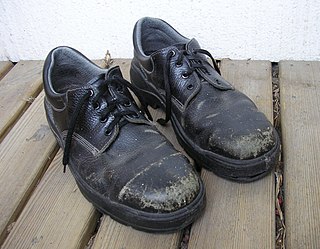
A floor is the bottom surface of a room or vehicle. Floors vary from simple dirt in a cave to many layered surfaces made with modern technology. Floors may be stone, wood, bamboo, metal or any other material that can support the expected load.

To improve motorcycle safety, many countries mandate the wearing of personal protective equipment such as protective clothing and helmets. Protective clothing may include certain types of jackets, gloves, boots, and pants. Jackets meant for motorcyclists are typically made of leather or specialized man-made fabrics like cordura or Kevlar. These jackets typically include padding on the elbow, spine, and shoulder regions. This was once quite bulky, but modern technology and materials have made it unobtrusive. Gloves are generally made of leather or Kevlar and some include carbon fiber knuckle protection. Boots, especially those for sport riding, include reinforcement and plastic caps on the ankle and toe areas. Pants are usually leather, cordura, or Kevlar. Except for helmets, none of these items are required by law in any state in the USA, or in any part of the UK but are recommended by many of those who ride.
Flooring is the general term for a permanent covering of a floor, or for the work of installing such a floor covering. Floor covering is a term to generically describe any finish material applied over a floor structure to provide a walking surface. Both terms are used interchangeably but floor covering refers more to loose-laid materials.

The UL enterprise is a global safety science company headquartered in Northbrook, Illinois, composed of three organizations, UL Research Institutes, UL Standards & Engagement and UL Solutions.

A steel-toe boot is a durable boot or shoe that has a protective reinforcement in the toe which protects the foot from falling objects or compression. Safety shoes are effective in keeping the feet of industrial workers safe from sharp and heavy objects while working in factories.

Motorcycle boots are associated with motorcycle riders and range from above ankle to below knee boots. They have an outside of a typical boot but a low heel to control the motorcycle. To improve motorcycle safety, motorcycle boots are generally made from a thick, heavy leather and may include energy absorbing and load spreading padding, metal, plastic and/or composite materials to protect the motorcycle rider's feet, ankles and legs in an accident. For use in wet weather, some boots have a waterproof membrane lining such as Gore-Tex or SympaTex.

Laminate flooring is a multi-layer synthetic flooring product fused together with a lamination process. Laminate flooring simulates wood with a photographic appliqué layer under a clear protective layer. The inner core layer is usually composed of melamine resin and fiber board materials. There is a European Standard No. EN 13329:2000 specifying laminate floor covering requirements and testing methods.
Earthquake engineering is an interdisciplinary branch of engineering that designs and analyzes structures, such as buildings and bridges, with earthquakes in mind. Its overall goal is to make such structures more resistant to earthquakes. An earthquake engineer aims to construct structures that will not be damaged in minor shaking and will avoid serious damage or collapse in a major earthquake. A properly engineered structure does not necessarily have to be extremely strong or expensive. It has to be properly designed to withstand the seismic effects while sustaining an acceptable level of damage.

Guard, Guard rails, guardrails, railings or protective guarding, in general, are a boundary feature and may be a means to prevent or deter access to dangerous or off-limits areas while allowing light and visibility in a greater way than a fence. Common shapes are flat, rounded edge, and tubular in horizontal railings, whereas tetraform spear-headed or ball-finialled are most common in vertical railings around homes. Park and garden railings commonly in metalworking feature swirls, leaves, plate metal areas and/or motifs particularly on and beside gates.

Underfloor heating and cooling is a form of central heating and cooling that achieves indoor climate control for thermal comfort using hydronic or electrical heating elements embedded in a floor. Heating is achieved by conduction, radiation and convection. Use of underfloor heating dates back to the Neoglacial and Neolithic periods.

Fire-retardant fabrics are textiles that are more resistant to fire than others through chemical treatment of flame-retardant or manufactured fireproof fibers.
A sprung floor is a floor that absorbs shocks, giving it a softer feel. Such floors are considered the best kind for dance and indoor sports and physical education, and can enhance performance and greatly reduce injuries. Modern sprung floors are supported by foam backing or rubber feet, while traditional floors provide their spring through bending woven wooden battens.
A performance surface is a type of flooring with attributes suitable for dance or sport. The word performance in this context will refer to any means of displaying physical movement. This includes theatrical, athletic, and recreational forms of performance. However, these different disciplines all require specialized floors to accommodate their specific physicality. Performance surfaces are normally designed as a sprung floor with additional material or layers on top, to create a complete dance floor or sports floor. Dance performance surfaces are denoted by using a layer of Marley, a popular type of vinyl, on top of a sprung floor. Theatres often have a number of roll-out floors with different characteristics to satisfy the requirements of different forms of dance. In addition, athletic flooring has been found to require different and new technological mechanisms to enhance performance. Flooring for spaces like clubs or ballrooms also serves a different purpose and therefore utilizes different properties.
Green building on college campuses is the purposeful construction of buildings on college campuses that decreases resource usage in both the building process and also the future use of the building. The goal is to reduce CO2 emissions, energy use, and water use, while creating an atmosphere where students can be healthy and learn.

Abrasion is the process of scuffing, scratching, wearing down, marring, or rubbing away. It can be intentionally imposed in a controlled process using an abrasive. Abrasion can be an undesirable effect of exposure to normal use or exposure to the elements.

Package testing or packaging testing involves the measurement of a characteristic or property involved with packaging. This includes packaging materials, packaging components, primary packages, shipping containers, and unit loads, as well as the associated processes.
Floor slip resistance testing is the science of measuring the coefficient of friction of flooring surfaces, either in a laboratory or on floors in situ. Slip resistance testing is usually desired by the building's owner or manager when there has been a report of a slip and fall accident, when there has been a report of a near accident, or (preferably) before the flooring is installed on the property. Flooring is tested using a tribometer to discover if there is a high propensity for slip and fall accidents on it, either dry and/or when wet with water or lubricated with other contaminants such as kitchen grease, hydraulic oil, etc. There have been numerous floor slip resistance testing tribometers and lab devices produced around the world to measure both the static (stationary) and dynamic coefficient of friction, but presently there are only a few that have been proven to be reliable for obtaining useful safety results and that have current official test methods. Static coefficient of friction (SCOF) testing has always been unreliable for assessing safety in the wet condition, so any reliable slip resistance test will be measuring the available slip resistance to someone who is moving (dynamic) across the floor, and therefore will be assessing dynamic coefficient of friction (DCOF). If an instrument has no official published test method, or has a withdrawn test method, then there is a problem with the instrument, often being poor precision.
The Martindale is a unit for quantifying the abrasion resistance of textiles, especially when used for upholstery.











